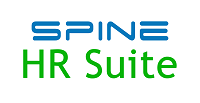Description

iHRMS

Spine Payroll
Comprehensive Overview: iHRMS vs Spine Payroll
Comprehensive Overview of iHRMS and Spine Payroll
a) Primary Functions and Target Markets
iHRMS (Integrated Human Resource Management System):
Primary Functions:
- Employee Information Management: Centralizes employee records with functionalities such as personal details, job roles, and performance history.
- Attendance and Leave Management: Automation of attendance tracking through biometric or other clock-in systems, coupled with leave management and approval workflows.
- Performance Management: Tools for setting objectives, performance reviews, and appraisals.
- Recruitment and Onboarding: Manages job postings, application tracking, and the integration of new hires.
- Reporting and Analytics: Generates HR reports for insights into workforce metrics.
Target Markets:
- Medium to large enterprises across various sectors requiring comprehensive HR processes.
- Industries including healthcare, education, manufacturing, and retail.
Spine Payroll:
Primary Functions:
- Payroll Processing: Automation of salary calculation, deductions, benefit disbursements, and generating pay slips.
- Statutory Compliance: Handles taxation, provident fund, and other statutory requirements.
- Employee Self-Service: Portal for employees to access pay slips, manage personal details, and request leaves.
- Integration Capabilities: Interfaces with accounting and other HR software systems.
Target Markets:
- Small to medium enterprises needing robust payroll solutions.
- Companies prioritizing compliance with regional and national payroll regulations.
b) Market Share and User Base
Determining the exact market share and user base for iHRMS and Spine Payroll is challenging without specific industry reports or detailed market research as these figures can fluctuate based on region and industry trends. Generally, both solutions have carved out niches within their respective target markets but have differing footholds:
-
iHRMS tends to have a stronger presence in larger organizations due to its comprehensive HR functionalities, making it less prevalent among smaller businesses that may not need its full suite of offerings.
-
Spine Payroll has a significant user base among small to medium businesses due to its focused approach on payroll processing and compliance, allowing it to capture enterprises looking for straightforward payroll solutions without extensive HR features.
c) Key Differentiating Factors
-
Scope of Functionality:
- iHRMS is a broad platform catering to the entirety of HR functions beyond just the payroll, making it ideal for organizations looking to integrate all HR operations into a single system.
- Spine Payroll focuses specifically on payroll solutions, with an emphasis on accuracy and compliance, making it suitable for businesses that require detailed and reliable payroll management.
-
Complexity and Implementation:
- iHRMS, due to its all-encompassing nature, might take longer to implement and require more training for users, thus aligning more with companies that have dedicated IT and HR departments.
- Spine Payroll, being more straightforward, often allows for quicker rollout and easier user adoption, appealing to small and mid-sized businesses.
-
Customization and Integration:
- iHRMS typically offers a higher degree of customization and can be integrated with different modules tailored to various business needs, which can be an advantage for firms with diverse HR policies.
- Spine Payroll provides standardized processes with some customization in payroll but focuses on integrating smoothly with existing accounting systems, suiting businesses looking for seamless payroll functions.
-
Cost Considerations:
- Generally, iHRMS may entail higher costs due to its extensive functionality and complexity, while Spine Payroll offers a cost-effective solution for companies mainly interested in payroll efficiency.
Ultimately, the choice between iHRMS and Spine Payroll will largely depend on the size of the business, the complexity of its HR and payroll needs, and the budget available for HR management solutions. Companies requiring end-to-end HR management are more likely to veer towards iHRMS, while those prioritizing payroll accuracy and compliance may opt for Spine Payroll.
Contact Info

Year founded :
2015
Not Available
Not Available
India
Not Available

Year founded :
Not Available
Not Available
Not Available
Not Available
Not Available
Feature Similarity Breakdown: iHRMS, Spine Payroll
To provide a thorough feature similarity breakdown for iHRMS and Spine Payroll, I'll analyze them based on common HR and payroll functionalities, user interface comparisons, and unique differentiators. Here's a detailed look at how these two systems compare:
a) Core Features in Common
-
Payroll Management:
- Both iHRMS and Spine Payroll offer comprehensive payroll management features, including salary calculations, deductions, tax management, and compliance with regulatory standards.
-
Employee Self-Service:
- Both systems have self-service portals where employees can access their payslips, tax documents, and personal information.
-
Leave and Attendance Management:
- Both software platforms include functionality for tracking employee leave and attendance, allowing for automated calculations of leave balances and attendance records.
-
Compliance and Taxation:
- Both systems are equipped to handle statutory compliance needs, such as generating required reports and forms for tax filing and other regulatory requirements.
-
Reporting and Analytics:
- Both solutions provide reporting and analytics features that enable users to generate various reports related to HR and payroll data.
b) User Interface Comparison
-
iHRMS User Interface:
- Generally modern and user-friendly, designed to facilitate ease of navigation. iHRMS typically employs a clean design with dashboards that provide quick access to key HR and payroll metrics.
-
Spine Payroll User Interface:
- Spine Payroll also offers an intuitive interface but may have a slightly more functional design focused on efficiency and speed in executing tasks. It supports easy-to-read dashboards with comprehensive visibility into payroll operations.
c) Unique Features
-
iHRMS Unique Features:
- Customization and Integration: Often praised for its customization capabilities, iHRMS allows businesses to tailor the system to their specific needs more freely. It also supports integration with various third-party systems for a more comprehensive HR ecosystem.
- Talent Management: iHRMS may offer more advanced features related to talent acquisition and management, such as recruitment tracking and performance appraisals.
-
Spine Payroll Unique Features:
- Industry-Specific Solutions: Spine Payroll may offer more specialized features or modules catering to certain industries, making it particularly beneficial for businesses with unique payroll needs.
- Focus on Payroll Efficiency: Known for its robustness in handling complex payroll computations with speed and accuracy, which is a significant advantage for large-scale operations with complicated payroll matrices.
Conclusion
Both iHRMS and Spine Payroll have strong core HR and payroll management capabilities, with differences mainly lying in user interface design and specialized features. iHRMS is a robust, customizable solution with potential strengths in talent management, while Spine Payroll excels in efficient, industry-focused payroll processing. When choosing between the two, organizations should consider their specific needs and existing systems to determine which product's unique features align best with their operational goals.
Features

Recruitment Tools
Employee Management
Performance Management
Payroll Processing

Automated Payroll Processing
Comprehensive Reports
Compliance Management
Employee Self-Service
Best Fit Use Cases: iHRMS, Spine Payroll
iHRMS (Integrated Human Resource Management System) and Spine Payroll are software solutions designed to streamline HR and payroll operations. Each of these tools offers specific features that make them suitable for various types of businesses and scenarios.
a) Best Fit Use Cases for iHRMS
Types of Businesses or Projects:
-
Medium to Large Enterprises: iHRMS is ideal for medium to large businesses that need a comprehensive solution to manage their workforce. These businesses often have complex HR requirements that a robust system can address.
-
Organizations with Complex HR Needs: Companies that need to manage extensive employee data, track performance metrics, manage shifts or rosters, and handle compliance with various regulations would benefit from iHRMS's integrated approach.
-
Businesses with Remote or Distributed Teams: Organizations that operate across multiple locations or have a significant portion of employees working remotely can leverage iHRMS for centralized HR management.
-
Industries with High Turnover: Sectors like hospitality, retail, or customer service, which typically experience high employee turnover, can use iHRMS to manage onboarding, training, and offboarding processes efficiently.
b) Preferred Scenarios for Spine Payroll
Scenarios and Business Types:
-
SMEs and Startups: Small to medium enterprises or startups that require an efficient and user-friendly payroll system without the complexity of a full-scale HR management system find Spine Payroll ideal.
-
Organizations Focused on Payroll Efficiency: For companies where payroll processing is the primary concern, and where the HR functions are relatively simple, Spine Payroll offers straightforward and efficient payroll management.
-
Industries with Unique Pay Structures: Businesses in industries such as manufacturing or construction, where pay structures are more complex (including overtime, shift differentials, etc.), can benefit from Spine Payroll’s ability to handle such complexities seamlessly.
-
Companies with Frequent Changes in Payroll: Companies where employee payroll is frequently updated due to bonuses, commissions, or other variable components would find Spine Payroll beneficial for its adaptability and ease of updating records.
d) Catering to Industry Verticals and Company Sizes
iHRMS:
- Industry Vertical Focus: Can be customized for diverse industries such as healthcare, education, retail, and manufacturing. Its adaptability allows it to meet industry-specific HR requirements like compliance, shift management, and employee engagement.
- Company Size: Best suited for medium to large organizations due to its comprehensive nature. The system's scalability allows it to grow with the company, making it suitable for rapidly expanding firms.
Spine Payroll:
- Industry Vertical Focus: Offers industry-specific solutions tailored to meet the needs of sectors like the service industry, healthcare, and finance due to its strong payroll capabilities.
- Company Size: Primarily targeted at small to medium-sized businesses but can be scaled for larger organizations with specific payroll requirements. Its intuitive design makes it easy for small businesses without extensive HR departments to handle payroll effectively.
In summary, while iHRMS is best suited for organizations looking for a comprehensive HR management system, Spine Payroll is more appropriate for companies that need an efficient payroll solution. Each product serves different needs depending on the business focus, operational complexity, and industry characteristics.
Pricing

Pricing Not Available

Pricing Not Available
Metrics History
Metrics History
Comparing undefined across companies
Conclusion & Final Verdict: iHRMS vs Spine Payroll
To provide a conclusion and final verdict on iHRMS and Spine Payroll, let's go through each of the required points:
Conclusion on Overall Value
a) Best Overall Value:
When considering the best overall value between iHRMS and Spine Payroll, it ultimately depends on your organization's specific needs.
-
iHRMS might offer better value for organizations looking for a more comprehensive and integrated human resource management system with modules that extend beyond payroll, covering various HR functions.
-
Spine Payroll could provide better overall value for companies primarily focused on streamlining and optimizing payroll processes, with robust payroll features that cater to different industrial verticals.
Pros and Cons of Each Product
b) Pros and Cons:
iHRMS:
-
Pros:
- Comprehensive HR suite offering various modules like recruitment, talent management, and employee self-service.
- Strong integration capabilities with other enterprise systems.
- User-friendly interface which can reduce the learning curve for HR staff.
-
Cons:
- Might be more expensive due to its broad range of features.
- Could be overkill for organizations primarily interested in payroll functionality.
- Implementation and customization may require a longer timeline.
Spine Payroll:
-
Pros:
- Specializes in payroll management, ensuring in-depth functionality in this area.
- Typically easier to implement if only payroll functionalities are needed.
- Often more cost-effective for payroll-centric needs.
-
Cons:
- Limited HR functionalities compared to comprehensive HRMS solutions.
- May require integration with other HR systems if broader HR operations beyond payroll are needed.
- Could lead to issues with scalability if organizational needs expand beyond payroll.
Recommendations for Users
c) Specific Recommendations:
-
For Small to Medium Enterprises (SMEs): If your primary focus is payroll, and your HR needs are not complex, Spine Payroll might be the right choice with its specialized payroll capabilities and potentially lower costs.
-
For Larger Organizations or Businesses with Complex HR Needs: iHRMS could be the more suitable option due to its extensive HR capabilities beyond just payroll, offering a more holistic approach to human resource management.
-
Consider Integration Needs: If you have existing software systems, consider which product integrates better with your current infrastructure to optimize your workflow.
-
Evaluate Future Growth: Consider your organization's growth trajectory. If you anticipate needing more HR capabilities as you grow, starting with a more capable system like iHRMS might save time and resources in the long run.
In conclusion, the choice between iHRMS and Spine Payroll should be based on your current HR and payroll needs, budget constraints, future growth plans, and the importance you place on either comprehensive HR functionality or focused payroll features.
Add to compare
Add similar companies



